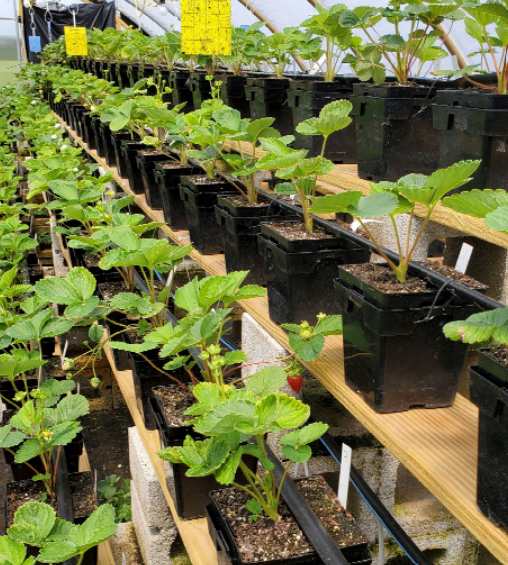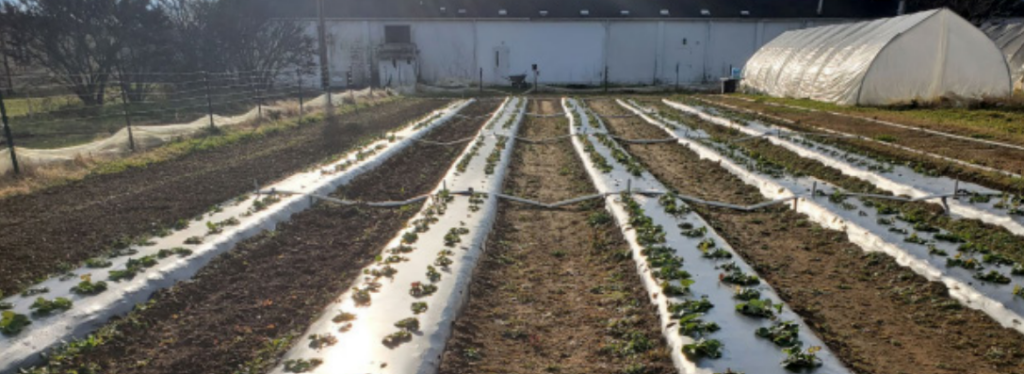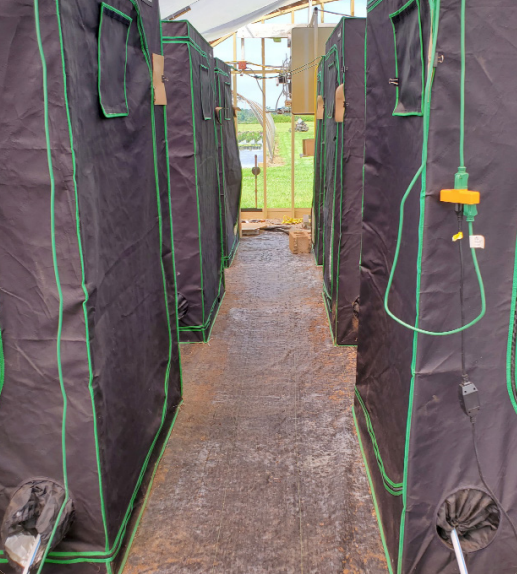Impact of Lighting on Strawberry Biology

Article and images by Edward Durner
Department of Plant Biology
Rutgers University, New Brunswick, NJ.
Most seasonal flowering strawberries (Junebearers) produce a single crop in the spring (except in Florida and California, USA) and are considered quantitative short-day (SD) plants at temperatures (<20C/<68F ), qualitative shortday plants at temperatures (>20C/>68F) and most fail to form flowers at any daylength at temperatures approaching 30C/86F. Recurrent or perpetual flowering cultivars (everbearers, day-neutrals and remontants) are qualitative long-day (LD) plants at high temperatures (27C/80.6F), quantitative LD plants at intermediate temperatures (between 10 and 27C/50 and 80.6F) and day-neutral at temperatures below 10C/ 50F regardless of whether they derive their LD character from California or European cultivars. The major difference among them is the temperature at which they become qualitative LD plants. The critical photoperiod for flowering of SD cultivars is between 12 and 15 hours (shorter at higher temperatures) and 15 hours (longer at higher temperatures) for LD cultivars.

Strawberry flowering is regulated via the pigment phytochrome and it is often manipulated using a night interruption (NI) of 3-hrs with low-level (<10 µmolesm-2 sec-1) incandescent lighting or a 4–8-hr daylength extension. Both treatments simulate long days under controlled or field conditions, and enhance flowering in LD cultivars and inhibit flowering in SD cultivars. LD simulation with incandescent light is effective because it contains both red and far-red wavelengths. Fluorescent light is deficient in far-red and is not effective. The physiological responses observed with either treatment are attributed to differences in the far-red fraction [(Amount of far-red light)/(Amount of far-red light + amount of red light)] of the light source with low far-red fractions (closer to 0) promoting SD responses and high far-red fractions (closer to 1) promoting LD responses. In many plants, blue light at higher levels (20 µmolesm-2 sec-1) can promote flowering in LD species and inhibit flowering in SD species, but at low levels (1-2 µmolesm-2 sec-1) blue light is generally ineffective.
In addition to the quality (wavelength) and quantity (µmolesm-2 sec-1) of light, photoperiodic flowering responses are sensitive to the timing of exposures during a 24-hr cycle. LED lighting makes it feasible to precisely time specific wavelengths during the 24-hr cycle to enhance flowering in both controlled and field systems or to enhance stolon production for controlled environment propagation. My research focuses on documenting the effects of supplemental LED lighting on flowering and vegetative growth in both long and short-day cultivars. In a recent study, I evaluated the growth responses of the LD, F1, seed-propagated cultivar ‘Soraya’ to a variety of light treatments. ‘Soraya’ is a seed-propagated cultivar from Europe. North American LD cultivars would
respond similarly based on published research from Norway. I used ‘Soraya’ to ensure sufficient plant material to complete the experiment. Growth was evaluated during and following 6 or 12 weeks of exposure to supplemental red (660 nm), far red (730 nm), blue (454 nm) or incandescent lighting at the beginning, middle (night interruption) or end of the dark period of a 10-hr, normally non-inductive photoperiod at non-inductive temperatures (>27/18C or >80.6/64.4F, day/ night) in light controlled tents.

of strawberry plugs.
Treatment effects were monitored via flower mapping and phenology during treatment, and field and greenhouse flower production after treatment, and floral scores derived by combining all evaluation criteria. The most promising treatment for enhancing the floral nature of plug plants was exposure to far-red + red light as a 5-hr night interruption. This treatment resulted in a multi-branched, floral plant with potential for use in either greenhouse or field production. Greenhouse runner production was substantially increased following exposure to incandescent lighting at the beginning of the dark period, thus this treatment may be suitable for enhancing vegetative propagation in controlled environments. As of last year, incandescent bulbs are no longer produced or sold in the United States. Any LED bulb or combination of red and far-red bulbs which emit a sufficient amount of radiation in the red and far-red portions of the spectrum should induce similar responses to those achieved with incandescents. This year, I am conducting a similar study with ‘Albion’, and ‘Royal Royce’ (both long day) (to verify responses observed in ‘Soraya’), and ‘Chandler’ and ‘Sweet Charlie’ (both short-day). Stay tuned…

- Categories: